#i will concede that it's interesting thinking about the work the dialogue and script have to do
Explore tagged Tumblr posts
Text
Doctors season 10 run (2008) - Part 1/3
Warning! Long post...
We're here for Matt Brown, Joplin's third appearance on the long, long, long running series Doctors. He's in seven episodes, so fingers crossed he's got fun things to do!
Episode 8: Light Fingers, Loose Tongues
Lurking in a bar looking unshaven and moody! With a spectacular eye roll when his sexist acquaintance brings along a guy who's only drinking water...
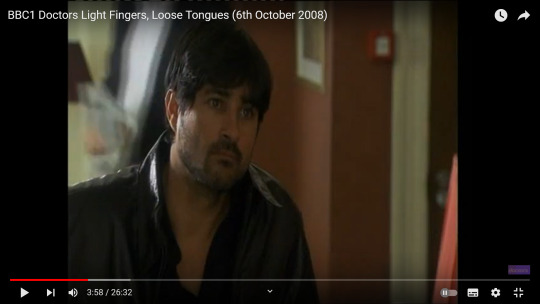
"A top man, loyal as the day is long." And apparently reminds the sexist businessman of himself as a kid, though he still hasn't had any lines.

His boss is an absolute wrong-un doing a lot of Crime I am sure and I suspect dear Matt is there to do the leg-breaking his boss is so fond of joking about.
Oooh his boss is a cop-killer. Hopes of Joplin actually having something interesting to do in his run of episodes hmm....fading.

He did just get to mumble a line or two though! I'm rooting for Hired Muscle with a Heart who will dob his boss in because he fancies Jess the undercover barmaid or something.
Anyway. Pretty in leather, though the haircut's a bit nerdy. Just ignore the fact he's laughing at his boss's sexist jokes.



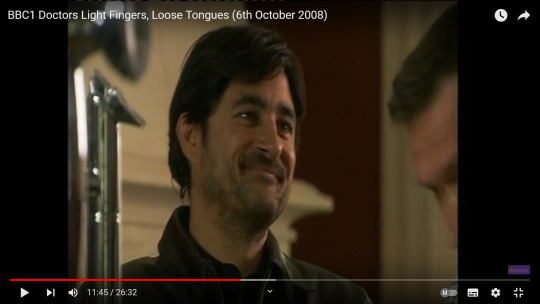

Uh oh is he onto Jill the undercover cop barmaid? Or is "Enjoy yer fag?" his idea of a chat-up line?


Hhhhhdhdgdgdhffff 🥵 smoulder smoulder





Undercover police lady bartender: "What's a nice lad like you doing hanging about with someone like him?"
Matt, sounding like language is a foreign concept: "I work for ‘im. So do you."
Undercover police lady bartender who’s decided she’s going to have to flirt her way out of this with the only attractive man at the table: "Well just make sure you don't pick up any of his bad habits..."
Episode 9: Walking on Sunshine
I wonder if there will be any actual doctors in this episode?
Ah Matt's sexist boss is called Jack, and also gets to have a few digs at 'the Lithuanians'. And Matt is on car-driving for the obnoxious business-school son duty.

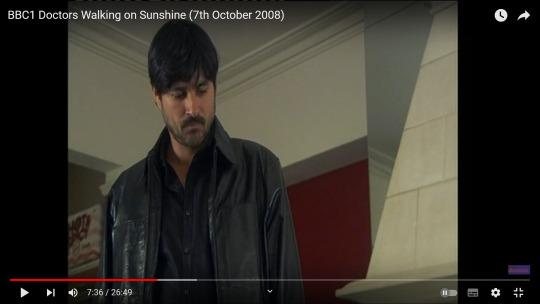
Ooh, bb doesn't like drugs and he doesn't like Jack's spoilt son Callum and he doesn't like the idea of giving the spoilt son a fancy car. It's about respect (for the car).
Apologies that I can't report much on this episode it features some amateur comic and I had to mute all his scenes because he drove me insane. Stand up comedy plus toddlers plus the miserable self-pitying doctor eurghh.
Ooh no, Matt's a good judge of character even among the criminal underworld - Jack's son is unhinged in a very unsubtle way. Luckily, Matt is good at first aid. Man with bloodied face lying behind the bins? "Bad."

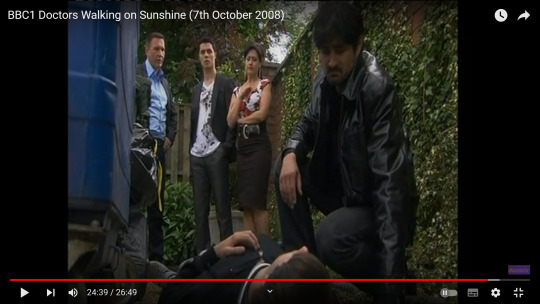
He was quite sweet and gentle getting the injured guy up and is now on 'subtly drop off the broken-nosed drug dealer at A&E duty'.
I almost gave up at the end of this because y i k e s was it dull but THEN the doctor that was annoying me got. Literally flattened by a massive truck and it was the funniest thing I've seen in ages. Solid ten-minute gut-busting laugh. On that endorphin high I will continue in the knowledge that the annoying doctor won't be back!
Episode 12: Hunger Strike
The university is selling out to ASDA (well, Walmart. Well "Novo-Mart") because it's broke. A student is on hunger strike. "Oh go and have some breakfast!" Sick burn, Treasurer.
Matt's still around, but he's lost the jacket. Joplin aficionados: I am trying to get a good look at the arm that has a scar in Death in Paradise.


Inconclusive. More research needed.


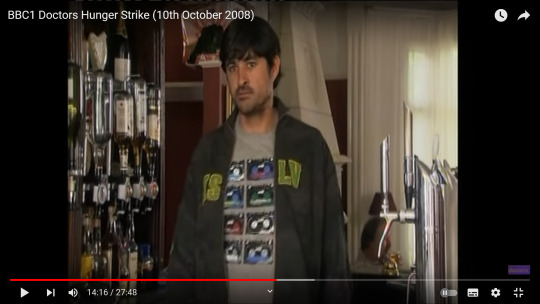
Damn he has a hoodie on now. And continues to be suspicious/vaguely threatening/maybe creeping on Jill the undercover bartender. Naughty naughty, hiding guns.


Took me an age to get these screenshots, it was like the director told him to chew his gum as obnoxiously as possible crol
Episode 14: Wooden Heart
Whatever happened in episode 13 at the bar I suppose I'll just have to figure out as best I can - Matt wasn't involved so I don't care! Basically, Jack is manipulative and controlling, his son is a psycho, and Jill the undercover policewoman had to pretend she was seeing the solicitor who knows who she is.
Boo, hiss, Jack is contemplating using a baby and its pram to smuggle Bad Things! Matt isn't present.
This is so weird. The dentist is Elvis.
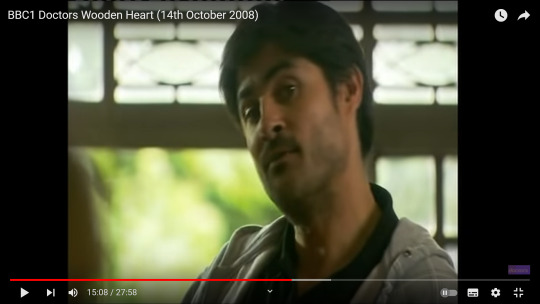

Oh HAI Matt! Costumes continue to become fluffier. More greys than blacks. Does it mean anything? He's openly snarking at the boss' psycho son and the teen mum who wants work running drugs in her pram...
"She's ok...if you're into gym slips."
"Might let you have a little go in her buggy an' all."
Well at least he gets to be a little bitch :')


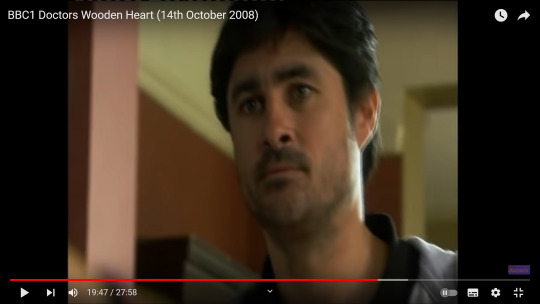
Ohhhhhhh my god is he gonna make his move on the undercover copper bar lady? SUCH a creep but still. Fucking would in a heartbeat.
He did not make a move :’) just Loomed.
Oh "don't you do anything but skulk?" but he's so good at it...
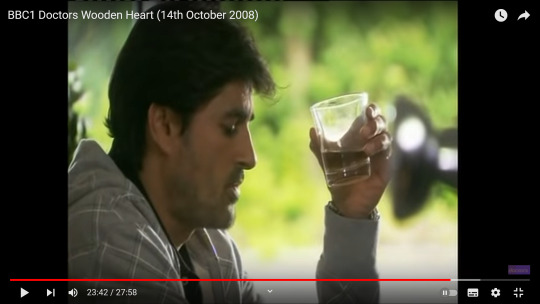

Those were like...the most lines he's had in this? Initiative and all that! Still menacing as fuck in a quiet way, still unclear if he's hitting on Jill, looking out for her, or threatening her.


"If I were you, I'd worry about your own back..."

---
TBC: This post is already way too long and the last four episodes he’s in (16, 17, 18, 19) are a run, so presumably link together more closely. I’ll try to do a part 2 tomorrow, for anyone who, like me, is simply dying to know what side Matt’s going to be on, and just how bonkers the denouement of this whole thing is going to be :))
#adventures in joplin sibtain's imdb page#joplin sibtain#bbc doctors#liveblogging daytime soaps#i will concede that it's interesting thinking about the work the dialogue and script have to do#when there are so many one-off/minor characters and they bring their stories with them#thank u joplin for that interview about eastenders that made me think a bit more about the genre#i still wouldn't choose to watch them without making it a little project with treats (screencaps)
1 note
·
View note
Text
Val Kilmer Documentary Punctures the Actor’s Bad Boy Myth
https://ift.tt/eA8V8J
Leo Scott and Ting Poo’s new documentary feature, Val, is not a mortality play. It is a rehearsal for an upcoming act. During a tour of his one-man stage show, Citizen Twain, Val Kilmer was diagnosed with throat cancer. The actor underwent two tracheostomies, and now can only speak while covering a tube. The narration of the new film is thus done by his son Jack Kilmer, allowing the pair to share a non-verbal connection throughout the journey, and through time and expression itself. While there are flourishes of humor, the documentary is a serious study of an artist who has always struggled to be understood, told through the selective memory of Kilmer’s POV.
“I’ve wanted to tell a story about acting for a very long time,” Kilmer says toward the beginning of the documentary. “And now that it’s difficult to speak, I want to tell my story more than ever.” Kilmer is an artist, one who takes his vocation very seriously and introspectively. An actor’s voice is more than a tool, it is their primary source of communication. Non-verbal exchanges are important, but dialogue is the primary idea delivery system in staged and filmed works. Surgical procedures have split his throat, shredding the scope of his instrument. In the film, Kilmer is forced to project his story on the empty space between the notes.
Among Kilmer’s many defining roles, the one which appears to ring truest is his encapsulation of Jim Morrison, the poet and lead vocalist of the Doors in Oliver Stone’s 1991 biopic, The Doors. The young Kilmer is shown onstage in a small club, lost in the music, awaiting his cue to become one with the mic. Moments in Kilmer’s personal history, like how the actor was tagged with a “difficult” label, are consigned to rests. The most overt reference to Kilmer’s “bad boy” reputation comes from Robert Downey Jr., who smashes the notoriety to bits in a moment of impromptu dismissal.
There is no gossip here. There is no discussion of A-list-bad behavior. Kilmer sees it all as artistic license. He was searching for honesty, he remembers. Choices like lying on top of a mattress filled with ice in order to feel a real pain during his last scene with Kurt Russell in Tombstone come across as perfectly valid. Kilmer is still bitter over spending four months learning to play guitar for Top Secret!, and his first note informs him the director thinks he looks funnier faking it. There is little evidence of unprofessionalism, only growing pains.
The bulk of Val comes from clips of 8mm home video footage Kilmer has been shooting most of his life. “I’ve kept everything, and it’s been sitting in boxes for years,” Kilmer informs us. The archive was intended to tell a story about “where you end and the acting begins.” We are gifted with moon shots of both Kevin Bacon and Sean Penn, which have nothing to do with the films Apollo 13 or The First.
Early self-directed screen tests provoke a series of what-ifs. A tortuous encapsulation of a Juilliard acting class is a lesson in what-nots. Val’s hand-held approach to The Island of Dr. Moreau is a highlight. The actor respectfully rocks his co-star and idol, Marlon Brando, on a hammock they both wish was strung to John Frankenheimer. Please turn off the camera, the film’s replacement director demands. But Kilmer only hits pause when it’s time to rehearse.
The behind-the-scenes camcorder footage from sets of Top Gun, Tombstone, and The Doors are treasure troves in themselves, and possibly underused. Most of the audience will be very interested in the candid youth and truth recorded over his career. Val uses the archival clips and unearthed b-roll to establish a chronology.
Many videos were made at home in Los Angeles with Kilmer’s younger brother Wesley, who had an epileptic seizure and drowned at age 15. His death casts a mournful pall following the news that Val was the youngest applicant ever accepted as a drama student at Juilliard. Kilmer calls his brother “an artistic genius,” and one of the most revealing things to come out of the documentary is how often Kilmer used this brother’s art to augment the backgrounds of the sets he is living through on film.
Seeing how Stone speaks about Kilmer now makes me wonder if Val would have been able to put in the same performances in his movies if he knew it at the time. In his audition tapes for Full Metal Jacket and Goodfellas, we see an actor who needs to be taken seriously. He flies 6,000 miles to hand deliver his tape to Stanley Kubrick in London.
While he makes no comment, footage reveals Kilmer’s favorite Batman was played by Adam West. “Every boy wants to be Batman,” we hear, and see the Caped Crusader in every era of Kilmer’s life. A short, animated film he and his brother made with what looks like crayon is a Batman spoof. He still glories in the moment he got deposited behind the classic TV series’ iconic wheels as a youngster visiting the lot. It appears Kilmer still can’t pass a grocery store Batmobile without feeding it quarters. He wears the classic blue Halloween ensemble expecting tricks and treats as a kid, and as a daddy with his kids.
Don’t expect to see Kilmer wearing his cinematic puffed rubber suit at home, and it’s not because he left it at the dry cleaners. Footage old and new, homemade or professionally recorded, presents the Batsuit as an albatross. Heavy rests the cowl. He has to be lifted from chairs, deposited on marks, and his only identifying feature on the set of Batman Forever is a chin and bottom lip. Anyone could have been behind the mask, and the human superhero envied the subhuman villains. Kilmer comes across as quite happy Jim Carrey and Tommy Lee Jones are able to create fully formed performance art in their portrayals. But he wanted to play with those toys.
“Batman Forever,” Kilmer laments, “whatever boyish excitement I had going in was crushed by the reality of the Batsuit. I realized it was just my job to show up and stand where they told me.” As the captured past footage is juxtaposed with modern sequences, we get an unfiltered glimpse of how little this has changed. The sequence of Kilmer at the Comic-Con autograph booth is wrenching. He initially didn’t want to take the part of Iceman in Top Gun because he felt it glorified the military. So many fans ask him to sign “You can be my wingman” on their souvenirs. It turns his stomach. He throws up in a garbage can and wheeled through hallways with a blanket over his head. Trouper that he is, he returns to the booth to finish out the signatures.
Kilmer blurred himself into the role of Mark Twain. There is a beautiful sequence where the actor walks through town to the beach, in full stage makeup, dressed in the signature white suit and long mustache of his character. It is extremely telling when Kilmer tells the camera it’s hard enough writing a good screenplay, much less a great one, which itself doesn’t even match what he feels he needs to bring to a script of a film version of Citizen Twain. Kilmer sold his ranch in New Mexico to finance the project. The documentary only captures some of the frustrations.
Most of the anecdotes are guarded, and all the admissions are part of a subjective narrative. Kilmer’s arc has rough edges, these tales are too smooth, and leave little room for impressionistic interpretation. Kilmer met his former wife, Joanne Whalley, when she was starring in a West End play directed by Danny Boyle, but he didn’t approach her.
“She was brilliant, and I was in town making fluff,” Kilmer concedes. It’s all about the art, even appearances. The documentary hints that Kilmer’s dedication to character did the most damage to their relationship. Wearing the same pair of leather pants for nine months could almost be on the books as probable cause for divorce in Hollywood.
Similarly, Kilmer’s Christian Science upbringing is brought up, and dropped. There is a loving but ambiguous undertone to Kilmer’s relationship with his once-rich-and-powerful father, who put his son in debt after trying to become a southern California land tycoon. But a sequence on his Swedish mother which juxtaposes a car ride he took with her when he was a child with one of being driven to her funeral speaks volumes without words.
Val is about the next step. “What’s past is prologue” William Shakespeare wrote in The Tempest. Kilmer pondered the “too, too solid flesh” while rehearsing Hamlet, and the documentary opens after the actor faced his own mortality. Kilmer swears he feels better than he sounds and, while he finds little to regret in his memories, he expects less in the ones he has yet to create.
Val can be seen on Amazon Prime Video.
cnx.cmd.push(function() { cnx({ playerId: "106e33c0-3911-473c-b599-b1426db57530", }).render("0270c398a82f44f49c23c16122516796"); });
The post Val Kilmer Documentary Punctures the Actor’s Bad Boy Myth appeared first on Den of Geek.
from Den of Geek https://ift.tt/2VvZ2lA
5 notes
·
View notes
Text
Suits: Cairo (9x04)
This episode felt a little bit "after school special" to me. It was about respect in relationships, and all of the characters kept talking about it in this kind of simplistic and unrealistic way. That's not to say I hated everything in the episode, but it just wasn't my favorite.
Cons:
The biggest problem for me was embodied in the moment when Harvey, Louis, Samantha, and Alex all did their dramatic slow-motion walk into Faye's office. They found a way to stop her from taking away Donna's vote, which is something she wanted to do because of the conflict of interest between Donna and Harvey. So they're all marching towards her office, they go in there, and as a united front, explain to her that Donna will be keeping her vote, because they've waived the conflict, and she can't stop them. This is all very nice and everything, but during the scene I was distracted by the fact that Donna wasn't there. If Donna gets a vote, if Donna is a part of the leadership of the firm, why does she sit back and let other people save her? Why doesn't she even get a say at all? It felt very counter-intuitive to me, like it went against the message, to have Donna be absent for this pivotal scene.
Donna and Harvey's romance just feels so... performative to me. I'm trying to give it a fair shake. I'm trying to get to a place where I can think it's cute, and leave it at that. But honestly, I'm still feeling pretty underwhelmed. Donna is upset about potentially losing her vote, but instead of telling Harvey about it, she blows up at him about his strained relationship with her father. I know she was covering up for something else, but I still felt like Donna was being really unfair in this instance. After all, Harvey hadn't done anything wrong. Her dad was the one who was hesitant. Why is it only Harvey's job to fix it?
I also refuse to believe that Harvey is that stupid. He offers Donna's dad money to help with his business venture. He seems to think this is a gesture of goodwill, but obviously Donna's father is deeply offended and feels disrespected. I thought Harvey was supposed to be this master at reading people? This was a dumb move, even for him. The second he mentioned the deal, I cringed, knowing it wouldn't be going his way.
And the dialogue is just so on-the-nose. Harvey makes a mistake, then has to learn his lesson and then has to tell us his lesson like he's giving a report at school. It's all very trite. That moment at the end where Harvey tells Donna they're going to be together forever was supposed to romantic, but for me it felt just as performative as the rest of their relationship. The actors are not doing a bad job at all, and they do have some degree of chemistry, but it's all just too... scripted.
For the most part I enjoy Alex and Samantha's friendship, and how Alex and Rosalie are welcoming Samantha into their family. But again, the theme of the episode just felt too blunt. I've never been a huge fan of the flashback stuff on Suits either, especially when, like in this episode, the flashbacks tell us something we already knew. Everything about Alex's story, how he was blackmailed and made to look complicit in a murder and cover-up, was old information. We were reminded of it on the "previously on." And other than the parts about Alex lying to his wife, there is absolutely nothing new in these flashback scenes. Or at least nothing new that matters.
Pros:
I feel like that was a very negative "Cons" section. It's not like I despise this episode or anything. There were plenty of things to enjoy.
For example, I still think Faye is a really interesting villain. Obviously there are a lot of things at play here, but she's not wrong to bring up the conflict of interest. She's not wrong to ask these people to work within a code of conduct. And she's not wrong that their attitude has been awful from day one. Of course, in this case I'm not 100% on her side, because I think Donna deserves her vote along with everyone else. But Faye isn't entirely wrong to be worried. Although I think it's stupid that she stole Gretchen from Louis (because that's not how secretaries in law firms work!) I like that Faye decides to give her back, admitting defeat in this one instance. I think she's probably gearing up to continue her fight against the name partners, but for now, she must concede the battle.
As I said, I love the continued theme of Alex and Rosalie welcoming Samantha into their family. They invite her over for board games, they make her feel at home with them and their kids. On the flip side, Samantha shows her loyalty and respect for them by doing what she can to get Alex out of a sticky situation. It was so cute that Alex and Rosalie were basically fighting over who was going to take a risk for whom. Samantha stepped in and made the play herself, because she could keep a level head about it. It looks like Alex is off the hook for now!
The cheesy dialogue and somewhat clumsy themes in this episode were definitely a problem, but the one place that the cheesiness worked for me was when Harvey was talking with his mom. It was such a satisfying character moment for Harvey when he patched things up with her, and now for him to call and tell her about Donna, and introduce these two women over the phone, is just so sweet and adorable. Harvey learned to be vulnerable and loving with the women in his life, and it's one of the most nuanced and satisfying character growth plot threads I've ever seen on TV. No joke.
Katrina and Louis' friendship is tested slightly, but once again we see evidence of Louis' maturity. He asks Katrina to do something risky and shady, and tries to pressure her because of their relationship. Katrina decides ultimately not to do it, and puts Louis in his place for asking her in the first place. I feel like the old Louis would not have backed down. He would have pushed and pushed and made things so much worse. But instead, he calms down, and he apologizes. I love Katrina for standing her ground, and Louis for respecting her choice!
Not much to say in the Mike Ross corner this week. His name was mentioned a few times in the context of throwing blame around for Jessica's disbarment, but that was about it. But next week? MIKE IS BACK AND I AM LIVING FOR IT! I can't wait to check back in, after I see the episode!
7/10
4 notes
·
View notes
Photo


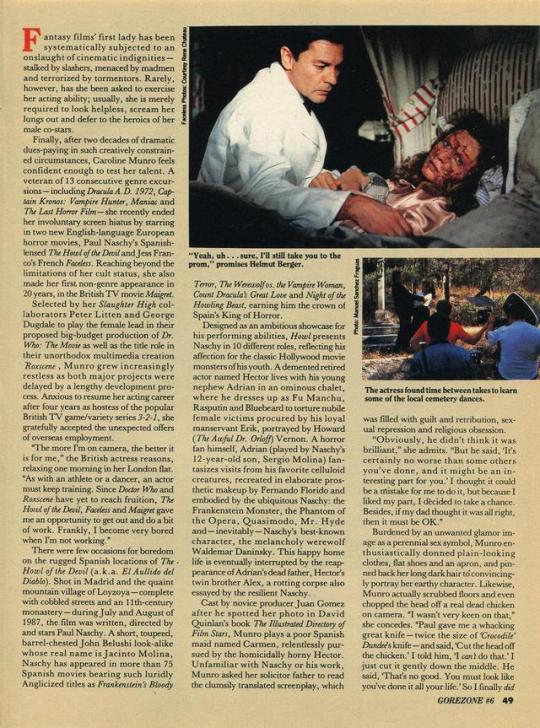

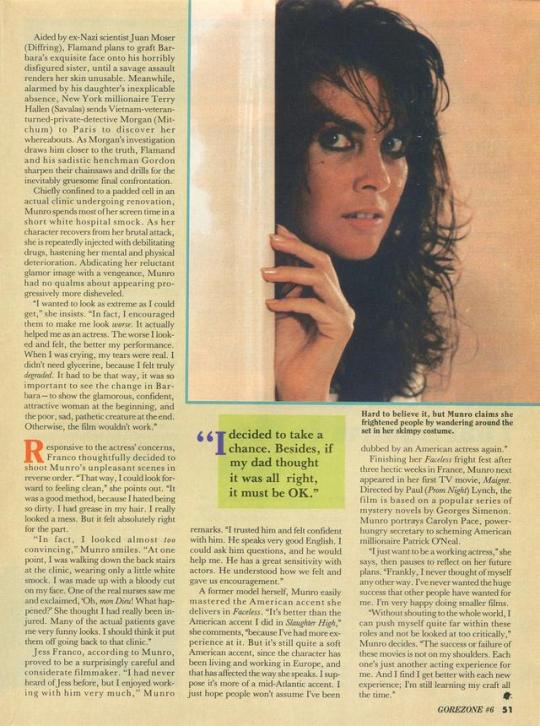

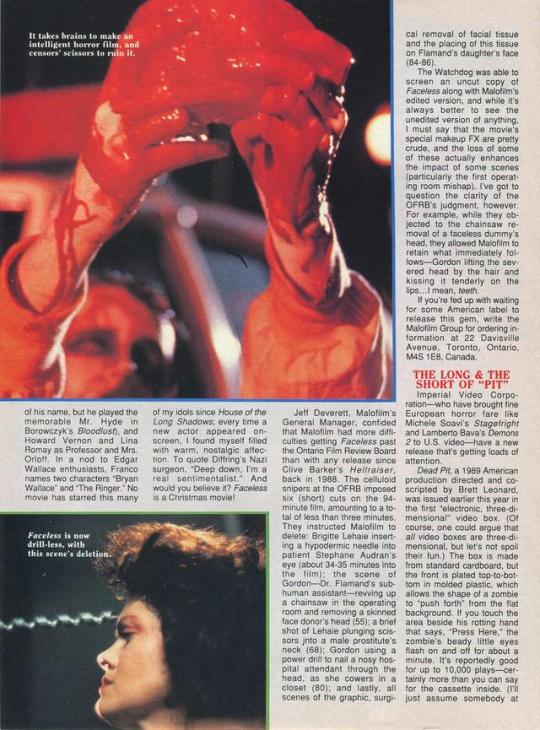
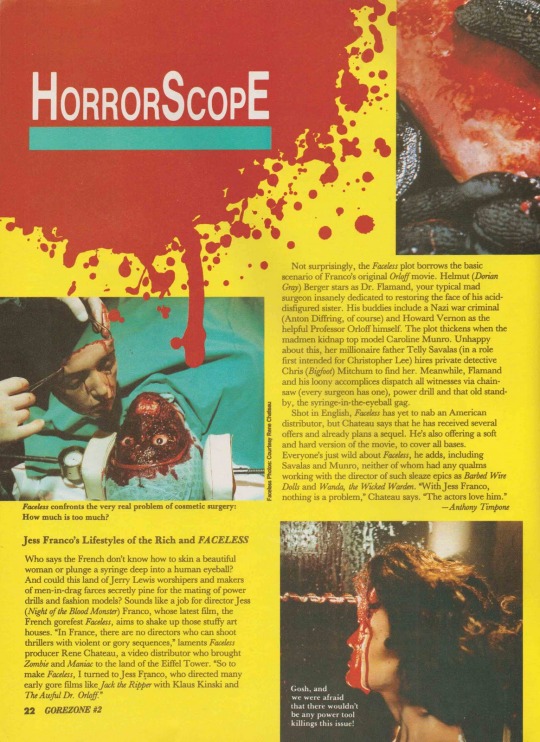
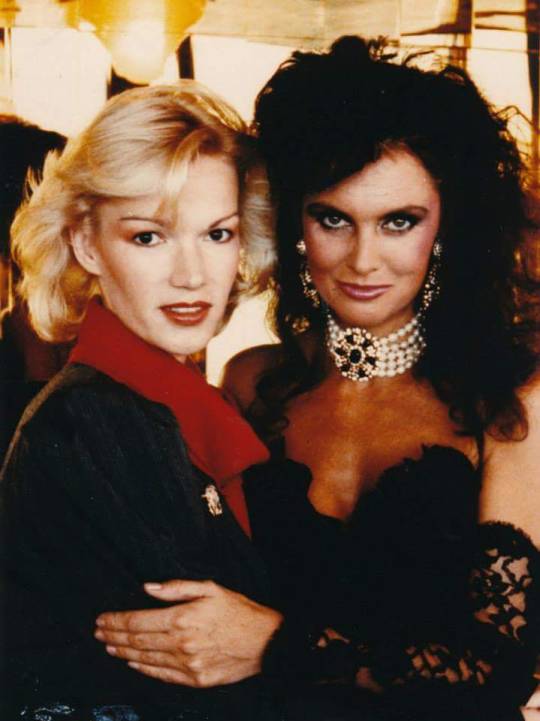
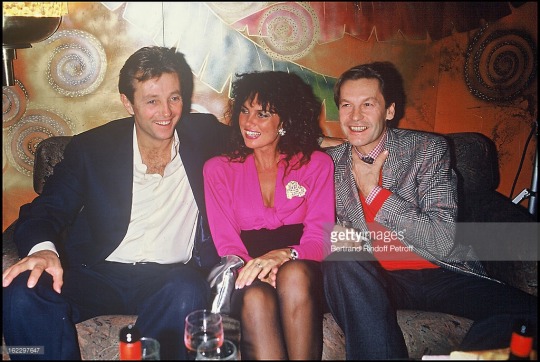
#FlashbackFriday to Jess Franco’s Faceless/Gorezone Issue 6
Toward the end of the decade of decadence (aka the 80s) exploitation auteur Jess Franco attempted to break into the commercial horror market. Faceless is the most notable production, with a cast that brings together ex-porn actress (and Jean Rollin regular) Brigitte Lahaie, British genre icon Caroline Munro, German character actor Anton Diffring, Luchino Visconti muse Helmut Berger, and seventies US TV and film superstar, Telly Savalas! Although still a low budget affair, this Rene Chateau production does offer a slick and glamourous look, unlike anything typically seen in a Jess Franco production.
Dr Frank Flamand (Helmut Berger) runs a posh clinic that specialises in expensive beauty treatments and quack "youth-enhancing" therapies for the excessively rich and vain. What his pampered clients do not know though is that many of their treatments are developed at the expense of kidnapped experimental subjects who are kept prisoner in the soundproof padded cells behind a locked door deep within the labyrinthine corridors of the clinic!
When a dissatisfied patient (who was horribly scarred during bungled plastic surgery) attempts to gain revenge by throwing acid in Flamand's face, she instead hits his beautiful sister, Ingrid (Christiane Jean) and badly disfigures her. Flamand vows to restore the beauty of his beloved sister and, together with his ice-cold assistant (and lover) Nathalie (Brigitte Lahaie), organises the kidnapping of coke-addicted model Barbara Hallen (Caroline Munro) with the intention of using her in a new face-transplant operation he intends to develop for his sisters benefit. Barbara is the daughter of wealthy industrialist Terry Hallen (Telly Savalas) and after his daughter's disappearance, Hallen hires American private detective Sam Morgan (Chris Mitchum) to find her. Meanwhile, Flamand and Nathalie consult Dr. Karl Heinz Mozer (Anton Diffring), an ex-Nazi associate of Flamand's mentor Dr Orloff (Howard Vernon), and employ him to help them experiment on more kidnapped victims in their attempts to perfect the complicated operation.
Gorezone Issue 6: Caroline Does Splatter by Steve Swires
Fantasy films’ first lady has been systematically subjected to an onslaught of cinematic indignities — stalked by slashers, menaced by madmen and terrorized by tormentors. Rarely, however, has she been asked to exercise her acting ability; usually, she is merely required to look helpless, scream her lungs out and defer to the heroics of her male co-stars.
Finally, after two decades of dramatic dues-paying in such creatively constrained circumstances, Caroline Munro feels confident enough to test her talent. A veteran of 13 consecutive genre excursions— including Dracula A.D. 1972, Captain Kronos: Vampire Hunter, Maniac and The Last Horror Film — she recently ended her involuntary screen hiatus by starring in two new English-language European horror movies, Paul Naschy’s Spanish-lensed The Howl of the Devil and Jess Franco’s French Faceless. Reaching beyond the limitations of her cult status, she also made her first non-genre appearance in 20 years, in the British TV movie Maigret.
Selected by her Slaughter High collaborators Peter Litten and George Dugdale to play the female lead in their proposed big-budget production of Dr. Who: The Movie as well as the title role in their unorthodox multimedia creation Roxscene, Munro grew increasingly restless as both major projects were delayed by a lengthy development process. Anxious to resume her acting career after four years as hostess of the popular British TV game/variety series 3-2-1, she gratefully accepted the unexpected offers of overseas employment.
“The more I’m on camera, the better it is for me,” the British actress reasons, relaxing one morning in her London flat. “As with an athlete or a dancer, an actor must keep training. Since Doctor Who and Roxscene have yet to reach fruition. The Howl of the Devil, Faceless and Maigret gave me an opportunity to get out and do a bit of work. Frankly, I become very bored when I’m not working.”
There were few occasions for boredom on the rugged Spanish locations of The Howl of the Devil (a.k.a. El Aullido del Diablo). Shot in Madrid and the quaint mountain village of Loyzoya— complete with cobbled streets and an 11th-century monastery — during July and August of 1987, the film was written, directed by and stars Paul Naschy. A short, toupeed, barrel-chested John Belushi look-alike whose real name is Jacinto Molina, Naschy has appeared in more than 75 Spanish movies bearing such luridly Anglicized titles as Frankenstein’s Bloody Terror, The Werewolf vs. the Vampire Woman, Count Dracula’s Great Love and Night of the Howling Beast, earning him the crown of Spain’s King of Horror.
Designed as an ambitious showcase for his performing abilities, Howl presents Naschy in 10 different roles, reflecting his affection for the classic Hollywood movie monsters of his youth. A demented retired actor named Hector lives with his young nephew Adrian in an ominous chalet, where he dresses up as Fu Manchu, Rasputin and Bluebeard to torture nubile female victims procured by his loyal manservant Erik, portrayed by Howard Vernon. A horror fan himself, Adrian (played by Naschy’s 12-year-old son, Sergio Molina) fantasizes visits from his favorite celluloid creatures, recreated in elaborate prosthetic makeup by Fernando Florido and embodied by the ubiquitous Naschy: the Frankenstein Monster, the Phantom of the Opera, Quasimodo, Mr. Hyde and — inevitably— Naschy’s best-known character, the melancholy werewolf Waldemar Daninsky. This Happy home life is eventually interrupted by the reappearance of Adrian’s dead father, Hector’s twin brother Alex, a rotting corpse also essayed by the resilient Naschy.
Cast by novice producer Juan Gomez after he spotted her photo in David Quinlan’s book The Illustrated Directory of Film Stars, Munro plays a poor Spanish maid named Carmen, relentlessly pursued by the homicidally horny Hector. Unfamiliar with Naschy or his work, Munro asked her solicitor father to read the clumsily translated screenplay, which was filled with guilt and retribution, sexual repression and religious obsession. “Obviously, he didn’t think it was brilliant,” she admits. “But he said, ‘It’s certainly no worse than some others you’ve done, and it might be an interesting part for you.’ I thought it could be a mistake for me to do it, but because I liked my part, I decided to take a chance. Besides, if my dad thought it was all right, then it must be OK.”
Burdened by an unwanted glamor image as a perennial sex symbol, Munro enthusiastically donned plain-looking clothes, flat shoes and an apron, and pinned back her long dark hair to* convincingly portray her earthy character. Likewise, Munro actually scrubbed floors and even chopped the head off a real dead chicken on camera. “I wasn’t very keen on that,” she concedes. “Paul gave me a whacking great knife — twice the size of Crocodile’ Dundee’s, knife— and said, ‘Cut the head off the chicken.’ I told him, I can’t do that.’ I just cut it gently down the middle. He said, ‘That’s no good. You must look like you’ve done it all your life.’ So I finally did cut the head off. It was a touch of the Tom Savini there.” A popular genre figure in Europe and Japan, Naschy has yet to conquer the more demanding American market, his voice will subsequently be dubbed by an American actor. This unusual production problem created an awkward acting situation for Munro, who performed her part with her normal British accent, at Naschy’s instruction. “It was a bit more difficult than I was used to, but that made it more of a challenge,” she notes. "Most of the master shots were done over Paul’s shoulder, showing me speaking. Some of the time, he was actually speaking Spanish. Because I understand Spanish fairly well and I knew the intention of the scenes, I could tell what he was saying and when it was time for me to speak. “I was nervous at first, because Paul is a foreboding-looking fellow with a great deal of energy. He is very intense in his work, very European in his approach, with extraordinarily piercing eyes. But he was exactly right for his character. Once we began working together, I found him quite easy to get on with.” Naschy even allowed Munro to rewrite her own dialogue. “I’m hopeless at writing,” she maintains. “But the script left something to be desired, because it was translated too literally from Spanish to though three of his films were released here theatrically in the mid- 1970s by Sam Sherman’s Independent-International Pictures and several of his other movies are currently available on home video. To facilitate American distribution, Naschy shot The Howl of the Devil since he doesn’t speak the language, he delivered his dialogue phonetically, and English. Many of the lines were archaic and ungrammatical. So I rewrote my dialogue to make it more conversational. I offered to help rewrite the rest of the dialogue as well, but Paul didn’t want to confuse the other actors.” Adding her creative input in such a manner is a new occurrence for Munro, who previously would passively accept her scenes as written, regardless of any misgivings. “That comes with experience,” she observes. “You learn what you will or won’t do in a scene. There are certain things I won’t do. Generally, there isn’t much substance to the characters in most genre movies, unless you create some for yourself. Now, I feel I’m in a position — at my age — to be thinking more about characterization.” Munro, satisfied with her Spanish sojourn, believes The Howl of the Devil will spotlight a more self-confident side of her acting personality. “I won’t say I enjoyed every minute,” she acknowledges, “but I was certainly kept on my toes. I hope people will see more range from me as an actress than they’ve seen before. I had to extend myself more in the role. I had some initial reservations, but everything felt right while we were making it. There was nothing about my scenes that offended me. Of course, I don’t know how the finished film will turn out, but for my part, I’m really pleased I did it.” Completing her Howl of the Devil role in 12 shooting days over a three-week period, Munro next flew to Geneva, Switzerland to star in the unusual industrial show The New Travels of Marco Polo. While in Geneva, she was contacted by director Jess Franco, offering her a leading role in his latest thriller Faceless. Filmed in and around Paris during November and December of 1987, Faceless (a.k.a. Les Predators de la Nuit) revives the moribund subgenre of surgical atrocity movies initiated in 1959 by Georges Franju’s classic Eyes Without A Face (a.k.a. The Horror Chamber of Dr. Faustus) and imitated by Franco’s own The Awful Dr. Orloff in 1961. The first feature produced by Rene Chateau, France’s leading video distributor, Faceless boasts an impressive international cast including Helmut Berger, Telly Savalas, Anton Diffring, Chris Mitchum and 79-year-old Howard Vernon , reprising his tireless Dr. Orloff persona. Jacques (Lifeforce) Gastineau provides graphic makeup FX. Doubling as screenwriter under the pseudonym “Fred Castle,” Chateau personally chose Munro, having seen her work in Starcrash and Maniac, which he released on video in France. In a resonant bit of casting, she plays jet-set American model Barbara Hallen, whose mysterious disappearance motivates the entire storyline. Kidnapped from a modeling session by actress Brigitte Lahaie (France’s most notorious porno queen in a rare mainstream role), Barbara is brought to a fashionable health farm run by sinister plastic surgeon Doctor Flamand (Berger), who constantly requires fresh blood and organs with which to rejuvenate his chic clientele.
Aided by ex-Nazi scientist Juan Moser (Diffring), Flamand plans to graft Barbara’s exquisite face onto his horribly disfigured sister, until a savage assault renders her skin unusable. Meanwhile, alarmed by his daughter’s inexplicable absence, New York millionaire Terry Hallen (Savalas) sends Vietnam-veteran-turned-private-detective Morgan (Mitchum) to Paris to discover her whereabouts. As Morgan’s investigation draws him closer to the truth, Flamand and his sadistic henchman Gordon sharpen their chainsaws and drills for the inevitably gruesome final confrontation.
Chiefly confined to a padded cell in an actual clinic undergoing renovation, Munro spends most of her screen time in a short white hospital smock. As her character recovers from her brutal attack, she is repeatedly injected with debilitating drugs, hastening her mental and physical deterioration. Abdicating her reluctant glamor image with a vengeance, Munro had no qualms about appearing progressively more disheveled. “I wanted to look as extreme as I could get,” she insists. “In fact, I encouraged them to make me look worse. It actually helped me as an actress. The worse I looked and felt, the better my performance.
When I was crying, my tears were real. I didn’t need glycerine, because I felt truly degraded. It had to be that way, it was so important to see the change in Barbara— to show the glamorous, confident, attractive woman at the beginning, and the poor, sad, pathetic creature at the end. Otherwise, the film wouldn’t work.”
Responsive to the actress’ concerns. Franco thoughtfully decided to shoot Munro’s unpleasant scenes in reverse order. “That way, I could look forward to feeling clean,” she points out. “It was a good method, because I hated being so dirty. I had grease in my hair. I really looked a mess. But it felt absolutely right for the part. “In fact, I looked almost too convincing,” Munro smiles. “At one point, I was walking down the back stairs at the clinic, wearing only a little white smock. I was made up with a bloody cut on my face. One of the real nurses saw me and exclaimed, ‘Oh, mon Dieu! What happened?’ She thought I had really been injured. Many of the actual patients gave me very funny looks. I should think it put them off going back to that clinic.”
Jess Franco, according to Munro, proved to be a surprisingly careful and considerate filmmaker. “I had never heard of Jess before, but I enjoyed working with him very much,” Munro remarks. “I trusted him and felt confident with him. He speaks very good English. I could ask him questions, and he would help me. He has a great sensitivity with actors. He understood how we felt and gave us encouragement.”
A former model herself, Munro easily mastered the American accent she delivers in Faceless. “It’s better than the American accent I did in Slaughter High,” she comments, “because I’ve had more experience at it. But it’s still quite a soft American accent, since the character has been living and working in Europe, and that has affected the way she speaks. I suppose it’s more of a mid-Atlantic accent. I just hope people won’t assume I’ve been dubbed by an American actress again.”
Finishing her Faceless fright fest after three hectic weeks in France, Munro next appeared in her first TV movie, Maigret. Directed by Paul (Prom Night) Lynch, the film is based on a popular series of mystery novels by Georges Simenon. Munro portrays Carolyn Pace, power hungry secretary to scheming American millionaire Patrick O’Neal.
“I just want to be a working actress,” she says, then pauses to reflect on her future plans. “Frankly, I never thought of myself any other way. I’ve never wanted the huge success that other people have wanted for me. I’m very happy doing smaller films. “Without shouting to the whole world, I can push myself quite far within these roles and not be looked at too critically,” Munro decides. “The success or failure of these movies is not on my shoulders. Each one’s just another acting experience for me. And I find I get better with each new experience; I’m still learning my craft all the time.”
7 notes
·
View notes
Photo

The fourth wall is pretty much demolished in Byrne’s She-Hulk run, but this issue really goes for it! There’s a Punisher, Wolverine and Spider-Man cover, with the text “Wolverine, The Punisher, Spider-Man starring on this issue!’, with She-Hulk making a small appearance at the bottom to say ‘But you’ll notice nothing is said about them actually being in this issue!’.
The credits are the result of a page and half gag leading to an Eisner style inclusion of the credits on in-panel objects, and then the actual plot (She-Hulk faces the Living Eraser) leads up to a few blank and almost blank pages. Actually, the first erasure gag is on the first page- as we start in media res and much of Shulkie’s top half has been erased as she exclaims ‘You think people buy this book for the stories?’
The immediate reference point for the blank pages, as Jen makes sure no one misses, is Byrne’s Alpha Flight story ‘Snowblind’. That had five pages of the hero Snowbird fighting one of the Great Beasts in a blizzard. As her costume is mostly white, the Great Beast took the form of a white bear and summoned a gigantic blizzard, everything became rather white for the duration, with only captions, speech bubbles and sound effects appearing on the page. The pages still had panels, however- here we get a couple of pages of absolutely nothing before Shulkie tears through the page.
Critics of the Alpha Flight story must have been apoplectic at this one- at least the white pages showed hints of comics work. They must have been scripted to have dialogue and captions, the effects hinted that the story was still going on somewhere- even when accusing Byrne of being lazy or making up for having too much work on his plate, they probably had to concede that there was some evidence of work on display there. But two pages of nothing in She-Hulk? Not even a word? The horror!
There’s definitely a case to be made that ‘Snowblind’ was an artistic decision, perhaps even a provocative one. Visibility would be poor in the circumstances, and perhaps the battles of supernatural creatures are not for human eyes? The provocation comes from denying readers the dramatic fight scenes some seem to believe comics are obliged to deliver. It’s an interesting thought that there might have been an element of undermining these questionable expectations and denying the audience this gratification, an almost perverse attempt to challenge the reader.
Here, the void is also justified by the narrative- using the Living Eraser’s abilities with no real knowledge of how to do so is risky, and it shouldn’t be surprising that She-Hulk erases more than she intended. Effectively, all of reality disappears (a foreshadowing/inspirational source of the Zero Hour blank final page effect?), and maintaining the empty page for a couple of pages serves as an attempt to emphasise the potential significance of error in judgement.
Of course, this is more of a funny book than an existential angst book, so rather than look for a long-winded solution, or proclaim the series dead due to the accidental erasure of its own existence, the situation is resolved with in-jokes, fourth wall breaking and echoes of the complaints that were no doubt made after Alpha Flight 6. Which is a very Byrne She-Hulk thing to do, so the whole thing comes together nicely- I am sure there must have been some complaints, but that’s two issues with blank pages that definitely worked for me, at least.
From The Sensational She-Hulk 37, by John Byrne, Keith Williams, Glynis Oliver & Jim Novak, reprinted in The Sensational She-Hulk by John Byrne:The Return
#comics#marvel#she-hulk#the sensational she-hulk#john byrne#alpha flight#blank page#fourth wall#keith williams
0 notes
Text
Siggraph 2017: the beginning of the end for assistant editors
Siggraph 2017 is essentially an NAB show for Pixar computer science geeks and VFX artists. But it also reveals the cutting edge of technology poised to make its way into the general post-production world. And for those paying attention, this year’s conference gave prescient insight as to how the job market may be eroded in the coming years.
The show floor itself was filled with the usual collection of VR hardware, motion capture companies, and VFX and 3D software (including the excellent new release of Fusion 9–stay tuned for an in-depth review shortly). But the real story was found within the dozens of technical papers presented during the conference sessions. Many of these have bizarre academic titles like “Variance-Minimizing Transport Plans for Inter-Surface Mappings”, “Harmonic Global Parametrization With Rational Holonomy” and “Spherical Orbifold Tutte Embeddings.” (I’m not making these up–they’re straight out of the Siggraph program.)
However there are several sessions that are much more direct in application. For example three of the lectures I attended involved researchers recreating facial animation from a single audio source with no video. Some of the results were remarkably organic.
To me one of the most interesting sessions was titled “Computational Video Editing for Dialogue-Driven Scenes.” In other words, how a computer can edit your scene for you.
Now the good news is that Michael Kahn and Paul Hirsch aren’t out of a job just yet. Their assistant editors, however, may well be. The most surprising thing about the paper is that the edit that the computer came up with wasn’t horrible. I’d encourage you to check out the short overview video below. Now it’s not going to win an academy award, but it was actually better than a lot of the mediocre editing that constantly makes it out into the real world.
The Stanford paper in a nutshell
Here’s how the system works: audio analysis aligns various takes with different portions of the script and different speakers. Facial recognition both identifies the actors in a given shot and the kind of shot based on the size of the face relative to the frame (e.g. a face that is close to the full height of the frame would be considered a close-up or extreme close-up, while a small face in frame would be considered a wide.) The system was actually pretty simple in its current implementation; given modern machine learning algorithms it would be relatively trivial to train such a system to identify and tag shots as OTS, cutaways, shots with camera bumps to be avoided etc.
Then idioms–the papers’ authors’ chosen term for cinematic language–are applied to get a desired edit. These idioms include: no jump cuts, start wide, and focus on a specific actor for emotional emphasis. Obviously all kinds of other idioms could be implemented.
The AI assistant editor
So again, to reiterate: I’m not suggesting that a computer will replace the important nuancing of emotion that makes great editors great. But think for a moment about the job of an assistant editor. Sort through footage, break out and arrange shots based on shot type, and sometimes create baseline edits from which another editor can begin. All these tasks are performed extremely well by this prototype project from Stanford.
Ultimately what this and similar technologies are disruptive is in eroding the traditional entry level platform into the industry. With less need for assistant editors, how does any editor get in the door to start working on high level content in the first place?
Like all disruptions in life, you can see this evolution of technology as threat or opportunity. It threatens to take away a slew of traditional jobs from the industry, but it also opens the door to individual creativity by removing more of the tedium that takes away from the creative.
Other takeaways from Siggraph
A few other observations from Siggraph: the film & video VR bubble, as predicted by many writers here, has burst. I found even the most avid evangelists from last year’s show were willing to concede to me that narrative storytelling in VR at a Hollywood level lacks a financial model. Most of the VR technology vendors are focused on VR and AR as a gaming platform or for industrial applications (arch viz, mechanical repairs etc.)
In the drone world, an interesting paper on multi-view drone cinematography showed promise for using drones to replace traditional steadicam and dolly shots, both indoors and outdoors. This includes the automatic avoidance of actors (i.e. not slicing your talent up with copter blades) and coordinating between drones so they don’t show up in each other’s shots. The indoor flight paths are still quite noisy due to air perturbations, but with cameras getting smaller and lighter I could see this being a viable alternative to dolly and jib work within the next couple of years.
Light field capture and display technology were also big at Siggraph. One particularly interesting light field capture method was a paper titled “Light Field Video Capture Using a Learning-Based Hybrid Imaging System .” What it essentially showed was the ability to combine a cheap Lytro camera with a standard DSLR to create effective light field video at a fraction of the price and bulk of existing methods. The paper addressed mainly using the technique for defocusing and rack focus in post, but it seems like it could be used for pulling quality keys without the need for a green screen. And while they combined the Lytro with a DSLR, there’s no reason that the same technique couldn’t be used with a higher-end camera.
The age of AI
One thing that ran throughout the technical papers: almost every paper used machine learning or deep learning (artificial intelligence algorithms) somewhere in the process pipeline. We don’t have to worry about Terminators or being plugged into a Matrix just yet, but there is a very real threat to jobs in highly technical areas previously considered immune.
I always feel like technological advancement is a mixed bag. I love having a smartphone, but I also remember a day when people left you to get a solid few hours of work done without having to constantly reply to emails, text messages and voicemails. At the end of the day, while I can be nostalgic for those less connected times, I’m not going to be able to stop the artificial intelligence revolution. The clear message: artificial intelligence is coming to our workplace and we need to start adapting.
The post Siggraph 2017: the beginning of the end for assistant editors appeared first on ProVideo Coalition.
First Found At: Siggraph 2017: the beginning of the end for assistant editors
0 notes
Text
Workshop I: Intros, Expectations, & An Old Lesson Remembered
(Quick note: I haven’t mentioned this blog to either the director or other writers of the forum. Until I do, if I do, I will just refer to them by the first initial of their first name.)
This past Sunday was the first workshop for FAU’s New Play Festival. I woke up early that morning, equally excited and nervous. I just kept wondering “what is it going to be like?”
Some of it was a case of classic enthusiasm but I also caught a twist of negativity riding under the thoughts. I think part of me was trying to undermine it. As if some overbearing force in my head thought it would be best to assume it wasn’t real or to make less of a deal out of it. It definitely wasn’t humility speaking.
I pushed it out of my mind and left the house early figuring it’d be best to help them set up. I spaced out on the drive over while listening to the Women of The Hour podcast. I recommend it.
I still ended up getting there a few minutes before we had to start. The director, M, welcomed me. He was my acting teacher for my sophomore year of high school. While acting was never a big passion of mine, it did help me to break out of my shell a bit. That was until my house burned down that December taking with it my interest in academics, acting, and life in general.
But this is different. I’m here as a writer, what I love and have trained to do. Hopefully my passion and dedication to that shows now, not to mention the maturity I’ve gained along the way.
So M goes over the schedule with us for the next month and the basics. We’re not going to do a staged reading where the actors move around, just a reading. While I’m 99% cool with this, an evil voice of doubt can’t help but use this as fuel. This isn’t legit. We’re just a couple of writers who are here doing this as a hobby. I am not a writer. I like to think this voice is just humility that just needs to learn to tone it down a bit.
I shake it off. That kind of mentality takes me out of the moment. We haven’t even read the scripts yet.
We start with mine. That voice of doubt got real quiet. I think he was nervous too. The reading goes well though. Some moments of humor hit well, particularly one my brother Nick had recommended. I get good advice, particularly in making sure my characters are all fleshed out.
The second play, written by A, is good. Like, really good. Sure, it has more work to be done and one lesser character could be cut or developed further but man, that dialogue blew me away. (I don’t want to say what the play was about, at least not at this time. Ideally, the other writers can tell you themselves if I end up interviewing them or something. If you’re in South Florida, you can see for yourself on May 10th.) A took her pain and made something of it. I’m excited to see where it goes. She tackles alcoholism, spousal abuse, and other themes that need to be talked about and does it with honesty and love for the characters.
The third play that was read came from S. When I tell you that we were all laughing from the first page, I don’t mean snickering. I mean full on struggling to hold it together. S wrote a 10 minute farce which is no easy feat. Even better, she wrote a good one. When M asked her what the theme she was going for was she smiled and said “Simple, men are louts. Except for my husband of course.” She was both playful and sincere in her words.
We finished up with the fourth play written by K. Just reading the setup about larping and role playing I was ready for a good time. The first couple of pages are just a good laugh with some truly vibrant characters. When the twist comes though, you really feel it. A character that seems a little lost to us is actually more certain than most of us. It’s a play that in 10 minutes reminds us that life isn’t worth living without purpose or better said, a quest.
Oh, that doubt I was talking about earlier? Yeah, turns out he was just an assuming asshole. Not only were these plays awesome but so were the people that wrote them. A asked S about her plays being performed in Texas, New York and a whole bunch of other places. Maybe you can just be good at something without broadcasting it like an insecure 24 year old? Who would’ve thought?
To be honest, I’m a little intimidated going back to make these revisions. It isn’t a new process and this play has already gone through a ton of iterations. That doubt has taken a new form, having conceded that the festival was legit. It was now back to attacking me, making me feel like I’ll just mess up what I already have.
I’m working on the revisions and doing my best to enjoy it. If you read all this, I hope it was entertaining. More so, I hope it reminds you to stop trying to validate experiences. Just let them be. You’ll probably find that more often than not, they can pleasantly surprise you.
0 notes